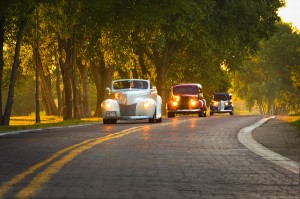 The Lincoln Highway was the first road across the United States of America. Conceived and promoted 100 years ago in 1912 by entrepreneur Carl Fisher, the Lincoln Highway went coast-to-coast from Times Square in New York to Lincoln Park in San Francisco. Originally passing through 12 states and covering almost 3,400 miles, the Lincoln Highway became affectionately known as “The Main Street Across America” and was the first national memorial to Abraham Lincoln, predating the dedication of the Lincoln Memorial in Washington, D.C. by nine years.
The Lincoln Highway was the first road across the United States of America. Conceived and promoted 100 years ago in 1912 by entrepreneur Carl Fisher, the Lincoln Highway went coast-to-coast from Times Square in New York to Lincoln Park in San Francisco. Originally passing through 12 states and covering almost 3,400 miles, the Lincoln Highway became affectionately known as “The Main Street Across America” and was the first national memorial to Abraham Lincoln, predating the dedication of the Lincoln Memorial in Washington, D.C. by nine years.
Back in 1912 only a few roads around towns and cities were gravel or paved with brick. A road was considered “improved” if it was graded. Most roads back then were just dirt – in dry weather they were dusty and bumpy, and in wet weather many were simply impassable. The worst part was that most of the roads spread out aimlessly from one settlement to another, leaving it much easier to just take the train.
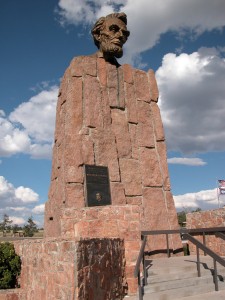 Carl Fisher was a brilliant man. For all of you that are race fans, we can thank him for the Indy 500. In 1909 he built the famous track and then paved it with over three million bricks. The first 500-mile race held at Indy was won on May 30, 1911 with an average speed of 74 mph. Another one of his famous ventures was the creation of one of the world’s greatest beach resorts when he turned a swamp into Miami Beach, Florida. In 1912, Carl had the grand idea of constructing a highway that would span the entire continent from east to west. The original name Carl picked for the project was the Coast-to-Coast Rock Highway.
Carl Fisher was a brilliant man. For all of you that are race fans, we can thank him for the Indy 500. In 1909 he built the famous track and then paved it with over three million bricks. The first 500-mile race held at Indy was won on May 30, 1911 with an average speed of 74 mph. Another one of his famous ventures was the creation of one of the world’s greatest beach resorts when he turned a swamp into Miami Beach, Florida. In 1912, Carl had the grand idea of constructing a highway that would span the entire continent from east to west. The original name Carl picked for the project was the Coast-to-Coast Rock Highway.
Back then, Carl estimated that his transcontinental graveled road would cost about ten million dollars to build – money he thought could and should be raised from automobile makers and other private companies. At that time, Congress, as a whole, was not ready to commit funding to these types of projects. His plan was for communities along the route to provide the equipment and in return they would receive free materials and a place along America’s first coast-to-coast highway.
It did not take Carl Fisher long to start raising money for the project. Frank Seiberling, president of Goodyear, and Henry Joy, president of the Packard Motor Car Company, both pledged money to Fisher’s idea and both played major roles in the highway’s overall development. Fisher knew that the success of his plan might also depend on the support of Henry Ford, but even with many persuasive attempts by close friends and associates, Ford refused to contribute because he believed that the government should build America’s roads. Without Ford’s support (and money) the project was in jeopardy.
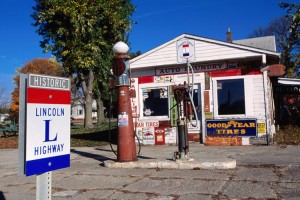 In an effort to gain public appeal (and money), Henry Joy came up with the idea of naming the highway after President Abraham Lincoln. On July 1, 1913, the official name of the highway was changed to the Lincoln Highway and the Lincoln Highway Association (LHA) was officially incorporated. Henry Joy was elected as president, while Carl Fisher was elected vice-president, but he was not present, as he had already departed with the Indiana Automobile Manufacturers Association on a trip to the West Coast (the “Hoosier Tour” was intended to explore possible routes for the highway and raise awareness about the project). Fisher kept the highway’s route a secret as long as he could because he wanted the nation as a whole to support the highway, not just the states through which it would pass – but also because he didn’t know what the route was! Once the route was announced, the highway was officially dedicated on October 31, 1913, even though there really wasn’t much of a highway.
In an effort to gain public appeal (and money), Henry Joy came up with the idea of naming the highway after President Abraham Lincoln. On July 1, 1913, the official name of the highway was changed to the Lincoln Highway and the Lincoln Highway Association (LHA) was officially incorporated. Henry Joy was elected as president, while Carl Fisher was elected vice-president, but he was not present, as he had already departed with the Indiana Automobile Manufacturers Association on a trip to the West Coast (the “Hoosier Tour” was intended to explore possible routes for the highway and raise awareness about the project). Fisher kept the highway’s route a secret as long as he could because he wanted the nation as a whole to support the highway, not just the states through which it would pass – but also because he didn’t know what the route was! Once the route was announced, the highway was officially dedicated on October 31, 1913, even though there really wasn’t much of a highway.
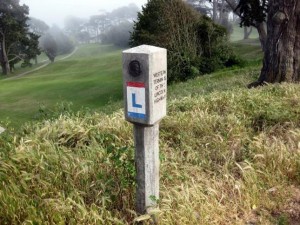 By 1914 no improvements had been made to the Lincoln Highway, and with Ford’s refusal to contribute and growing disinterest of people left off the route, the $10 million fund that Fisher had set up had stalled at the halfway point. Joy decided to abandon the fund and instead redirect the association to a new goal: educating the country about the need for good roads made of concrete, with an “improved” Lincoln Highway as the example. From there, the LHA oversaw the construction of concrete “seedling miles” out in the countryside to emphasize the superiority of concrete over unimproved dirt. As people learned about concrete, the LHA hoped that they would pressure the government to build better roads through their state.
By 1914 no improvements had been made to the Lincoln Highway, and with Ford’s refusal to contribute and growing disinterest of people left off the route, the $10 million fund that Fisher had set up had stalled at the halfway point. Joy decided to abandon the fund and instead redirect the association to a new goal: educating the country about the need for good roads made of concrete, with an “improved” Lincoln Highway as the example. From there, the LHA oversaw the construction of concrete “seedling miles” out in the countryside to emphasize the superiority of concrete over unimproved dirt. As people learned about concrete, the LHA hoped that they would pressure the government to build better roads through their state.
In 1921, the federal government passed the Federal Highway Act of 1921, which provided $75 million of matching funds to the states for road construction. The act required the states to identify 7% of their total miles as “primary” roads – and only these routes would be eligible for the federal funds. In most states in which it ran, the Lincoln Highway was the obvious choice, and major improvements finally began to be made along the cross-country route (even though the highway would not be completely paved until 1938).
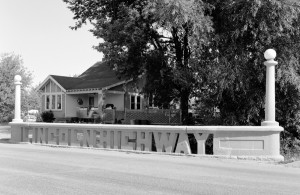 In ten years, between 1915 and 1925, the United States went from having one named highway to having an unorganized and confusing system of named highways. It was time for an organized national system of numbered highways. The LHA was all in favor of a numbered highway system, as long as the Lincoln Highway did not get chopped up into little numbered pieces. In March of 1925, the American Association of State Highway Officials (AASHO) started planning a new federal highway system, and in November of that year the plan was approved.
In ten years, between 1915 and 1925, the United States went from having one named highway to having an unorganized and confusing system of named highways. It was time for an organized national system of numbered highways. The LHA was all in favor of a numbered highway system, as long as the Lincoln Highway did not get chopped up into little numbered pieces. In March of 1925, the American Association of State Highway Officials (AASHO) started planning a new federal highway system, and in November of that year the plan was approved.
With this new highway numbering system (which most of us are familiar with today), major east-west routes would be numbered in multiples of 10, with US 10 crossing the southern portion of the country and US 90 crossing the north. US 1 would run from Maine to Florida and US 101 between Washington and California. All the major north-south routes would end in 1 or 5. The Lincoln Highway started on US 1 and then became US 30 for most of the route. Out west, it became US 530, then US 40, and then US 50. A set of standard road signs were then adopted, and all of the old markers of named roads were taken down to avoid confusion.
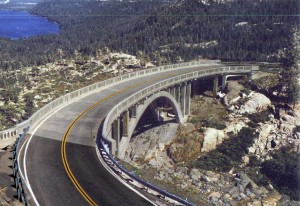 Once the markers of the named roads were removed, most of them were quickly forgotten. But, thankfully, the generation of Americans that had been exposed to the well-organized publicity of the LHA kept the Lincoln Highway alive long after the official significance had faded. The last major promotional activity of the LHA took place on September 1, 1928, when thousands of Boy Scouts installed about 3,000 small concrete markers at sites, about a mile apart, along the route to officially mark and dedicate the highway to the memory of Abraham Lincoln. But, as decades passed and younger generations came forth, the LHA ceased operations and the Lincoln Highway, like the others, also began to fade. But, by then, this road had left an indelible mark on America.
Once the markers of the named roads were removed, most of them were quickly forgotten. But, thankfully, the generation of Americans that had been exposed to the well-organized publicity of the LHA kept the Lincoln Highway alive long after the official significance had faded. The last major promotional activity of the LHA took place on September 1, 1928, when thousands of Boy Scouts installed about 3,000 small concrete markers at sites, about a mile apart, along the route to officially mark and dedicate the highway to the memory of Abraham Lincoln. But, as decades passed and younger generations came forth, the LHA ceased operations and the Lincoln Highway, like the others, also began to fade. But, by then, this road had left an indelible mark on America.
The Lincoln Highway is believed to have been the inspiration for the National Interstate and Defense Highways Act of 1956, which was championed by President Dwight D. Eisenhower, influenced by his experiences as a young soldier crossing the country in a 1919 Army convoy on the Lincoln Highway. Today, Interstate 80 is the cross-country highway most closely aligned with the Lincoln Highway.
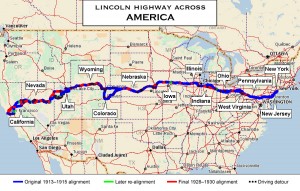 In the west, particularly in Wyoming, Utah and California, sections of Interstate 80 are paved directly over alignments of the Lincoln Highway. The highest point on the highway (on top of the mountain between Cheyenne and Laramie, Wyoming) was marked with a huge fourteen-foot tall bronze bust of Abraham Lincoln, sitting atop a massive thirty-five foot tall granite base. This monument may not see as many visitors as the memorial in Washington D.C. does every year, but that doesn’t make it any less special. Sitting high up on that mountain, looking down on a road that bears his name, in the snow, the wind (and it does get windy up there) and sunshine, “Honest Abe” vigilantly watches over the land that he loved. The monument, which was originally erected in 1959 on RT 30 about a half mile west of where it is now, was moved in 1969 to the rest area off the newly opened I-80 at exit 323, where it still proudly stands today.
In the west, particularly in Wyoming, Utah and California, sections of Interstate 80 are paved directly over alignments of the Lincoln Highway. The highest point on the highway (on top of the mountain between Cheyenne and Laramie, Wyoming) was marked with a huge fourteen-foot tall bronze bust of Abraham Lincoln, sitting atop a massive thirty-five foot tall granite base. This monument may not see as many visitors as the memorial in Washington D.C. does every year, but that doesn’t make it any less special. Sitting high up on that mountain, looking down on a road that bears his name, in the snow, the wind (and it does get windy up there) and sunshine, “Honest Abe” vigilantly watches over the land that he loved. The monument, which was originally erected in 1959 on RT 30 about a half mile west of where it is now, was moved in 1969 to the rest area off the newly opened I-80 at exit 323, where it still proudly stands today.
Thankfully, not everyone forgot about the old highway, and in 1992 the Lincoln Highway Association was reactivated and is now dedicated to preserving the road and its history. The LHA now has over 1,000 members located in 40 states, as well as Canada, England, Germany, Luxembourg and Scotland. The association has active state chapters in 12 Lincoln Highway states and maintains a national tourist center in Franklin Grove, Illinois. The building in which the association is based out of dates back to 1860 and can be traced to a distant relative of Abraham Lincoln, Henry Isaac Lincoln, who originally constructed the building as a dry goods store.
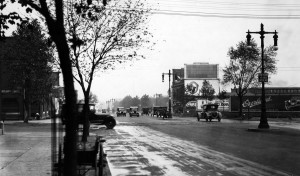 Next year, the LHA will celebrate the 100th anniversary of the Lincoln Highway with an official centennial tour of the road in June 2013. There will be an East Tour and a West Tour, starting simultaneously in New York and San Francisco, and then meeting mid-point in Kearney, Nebraska for a celebration held June 30 through July 2 at the Great Platte River Road Archway. An independent international motor tour will also travel the highway from July 1 through July 26. One hundred classic cars will be shipped to the United States and then driven the entire route before they are shipped back to Europe.
Next year, the LHA will celebrate the 100th anniversary of the Lincoln Highway with an official centennial tour of the road in June 2013. There will be an East Tour and a West Tour, starting simultaneously in New York and San Francisco, and then meeting mid-point in Kearney, Nebraska for a celebration held June 30 through July 2 at the Great Platte River Road Archway. An independent international motor tour will also travel the highway from July 1 through July 26. One hundred classic cars will be shipped to the United States and then driven the entire route before they are shipped back to Europe.
The next time you find yourself stuck somewhere, I would highly encourage you to search “Lincoln Highway” on your computer and take your own trip down America’s Main Street – the amount of pictures and information out there about this famous route is amazing. Many books have been written, complete with photos, which make you thankful someone had the foresight to know we needed concrete and asphalt roads! Maybe one day you’ll be stuck and have some time to go see some of the places you find on your search of this mostly gone-but-not-forgotten highway.
Long before Route 66 or the famous Eisenhower Interstate System, the Lincoln Highway was America’s original Main Street. I think it is awesome that the states are taking steps to preserve the history of this ground-breaking (literally) highway. And here we are, almost 100 years later, still enjoying the benefits of what it started. Thanks to visionaries like Carl Fisher and Henry Joy, we get to drive our sophisticated vehicles on what is still the best interstate highway system in the world!

1 Comment
Kim-
Wonderful article. Thanks so much for your accuracy and passion about the LH. Best regards from the Lincoln Highway Association!
Paul Gilger.